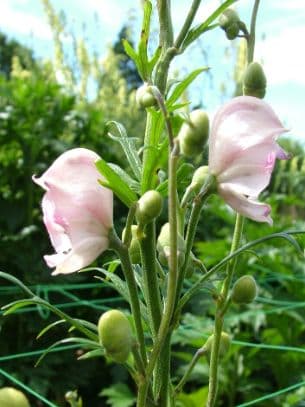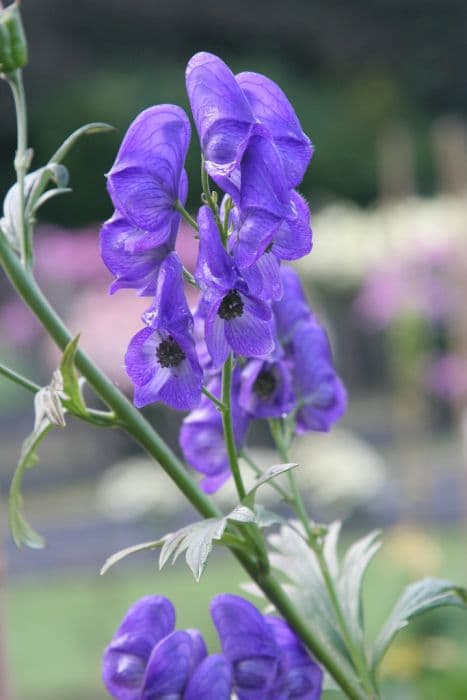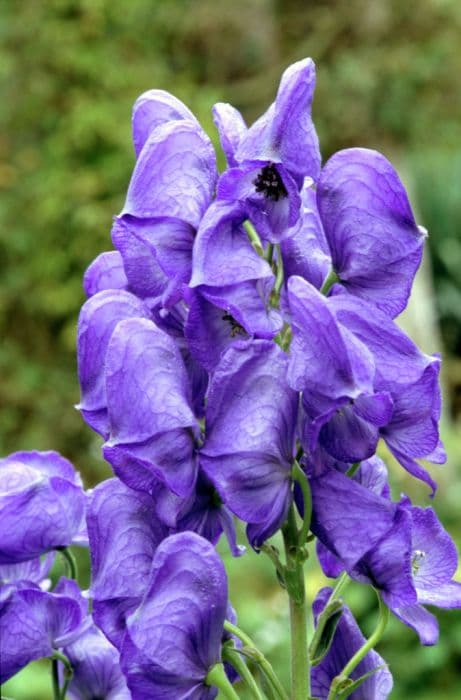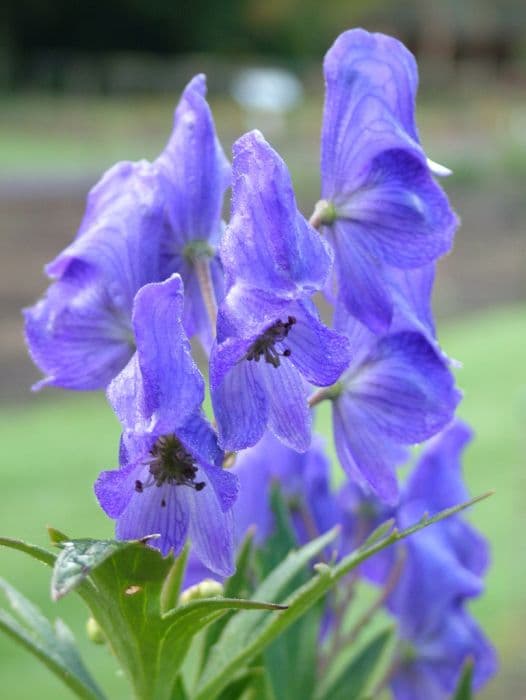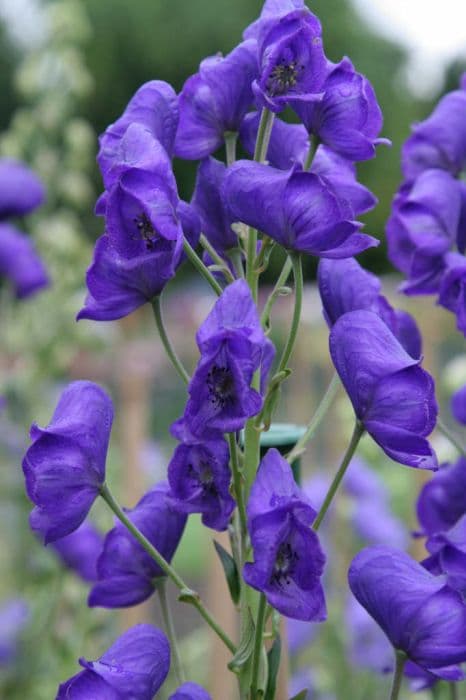Clematis Clematis 'Madame Baron-veillard' (LL)

ABOUT
The Clematis 'Madame Baron-Veillard' is a visually striking flowering vine that captivates onlookers with its generous display of blooms. The flowers of this clematis variety are well-known for their enchanting shades of pink, creating a soft yet vibrant tapestry of color. Each flower is sizeable and displays a delicate graduation of hues, ranging from a rich, deeper pink at the petal edges to a softer, lighter pink near the base. These blooms are further highlighted with a distinctive feature; the petal edges are slightly recurved, adding an elegant dimension to their overall form. The petals surround a central tuft of stamens, which typically show off a contrasting color, often a creamy yellow or white, drawing the eye to the heart of the flower. The leaves of the Clematis 'Madame Baron-Veillard' provide a lush backdrop to the floral display. They are deep green, lending a sense of vitality and freshness to the vine. The foliage has a glossy texture, often catching the light and subtly enhancing the visual impact of the plant. A vine by nature, this clematis variety has the ability to climb and twine around supports. Its climbing habit enables it to be a versatile addition to gardens, where it can gracefully ascend trellises, arbors, and other structures, draping them with its floriferous garlands. The Clematis 'Madame Baron-Veillard' brings a romantic ambiance to any garden setting, offering a long season of interest with its delightful flowers that can transform plain fences, walls, or other garden features into cascades of color. This clematis variety is an exceptional choice for gardeners looking to create vertical interest and capture the charm of English cottage gardens or to add a touch of elegance to more formal garden designs.
About this plant
 Names
NamesSynonyms
Late Large-Flowered Clematis, Madame Baron Veillard Clematis.
Common names
Clematis 'Madame Baron Veillard'
 Toxicity
ToxicityTo humans
The common name for Clematis 'Madame Baron-veillard' is Clematis. This plant is considered mildly toxic to humans if ingested. Clematis contains an irritant known as protoanemonin, which can cause symptoms upon ingestion such as nausea, diarrhea, vomiting, and salivation. If the plant comes into contact with the skin, it may cause dermatitis or skin irritation.
To pets
The common name for Clematis 'Madame Baron-veillard' is Clematis. This plant is also toxic to pets, including dogs and cats, and can cause similar symptoms as in humans. If ingested, pets may experience excessive drooling, vomiting, diarrhea, and in some cases, ataxia (loss of coordination). In severe cases, ingestion can lead to gastrointestinal upset or more severe health issues. It is advisable to keep pets away from this plant to prevent accidental ingestion.
 Characteristics
CharacteristicsLife cycle
Perennials
Foliage type
Deciduous
Color of leaves
Green
Flower color
Pink
Height
6-8 feet (1.8-2.4 meters)
Spread
2-4 feet (0.6-1.2 meters)
Plant type
Climber
Hardiness zones
4
Native area
Japan
Benefits
 General Benefits
General Benefits- Ornamental Appeal: Clematis 'Madame Baron Veillard' is valued for its vibrant pink flowers that add aesthetic beauty to any garden space.
- Vertical Interest: As a climbing vine, Clematis 'Madame Baron Veillard' creates vertical interest, covering trellises, arbors, or walls with attractive foliage and blooms.
- Seasonal Color: Blooming in late spring to early summer, this Clematis variety provides seasonal color and can also offer a second bloom in late summer or early fall.
- Garden Adaptability: This Clematis can be used for a variety of garden applications, including container gardening, making it versatile for different garden spaces.
- Wildlife Attraction: The flowers of Clematis 'Madame Baron Veillard' attract pollinators such as bees and butterflies, which are beneficial for the ecosystem.
- Companion Planting: This plant can be successfully paired with other garden plants, such as roses or shrubs, to create multi-textural displays.
- Privacy Screen: When grown on fences or trellises, Clematis 'Madame Baron Veillard' can act as a natural privacy screen.
 Medical Properties
Medical PropertiesThis plant is not used for medical purposes.
 Air-purifying Qualities
Air-purifying QualitiesThis plant is not specifically known for air purifying qualities.
 Other Uses
Other Uses- Photographic Backdrop: The vibrant blooms of Clematis can serve as a beautiful, natural backdrop for outdoor portrait photography.
- Education and Conservation: Clematis varieties can be used in botanical gardens and educational programs to teach about plant diversity and the importance of pollinators.
- Insect Habitat: Planting Clematis can create a small ecosystem that offers habitat and food for beneficial insects like bees and butterflies.
- Privacy Screening: When grown on fences or trellises, Clematis can provide a natural screen, giving privacy to gardens and yards.
- Artistic Inspiration: Artists can use the intricate structure and colors of Clematis flowers as inspiration for designs, paintings, and other creative works.
- Living Structures: When trained over archways or pergolas, Clematis can contribute to green living structures in gardens.
- Shade Provider: Clematis grown over arbors can offer a natural shady spot during the hot summer months.
- Seasonal Decorations: The vines and flowers of Clematis can be used in making seasonal wreaths and floral arrangements.
- Wedding Venues: Clematis-filled gardens can host weddings, with vines providing a romantic setting for ceremonies and photographs.
- Erosion Control: When planted on slopes, the roots of Clematis plants can help stabilize the soil and prevent erosion.
Interesting Facts
 Feng Shui
Feng ShuiThe Clematis is not used in Feng Shui practice.
 Zodiac Sign Compitability
Zodiac Sign CompitabilityThe Clematis is not used in astrology practice.
 Plant Symbolism
Plant Symbolism- Artistic Creativity: Clematis is often associated with creative expression due to its ornate and showy flowers.
- Mental Agility: Its ability to climb and adapt can symbolize a sharp intellect and flexible thinking.
- Spiritual Quest: The plant's upward growth habit suggests aspiration and the pursuit of higher realms.
- Beauty: With its beautiful blooms, Clematis often symbolizes beauty and aesthetics.
 Water
WaterClematis, commonly known as Jackman's clematis, should be watered regularly to maintain a moist, but not waterlogged, soil. During the growing season, water your Clematis with about 1 gallon of water once a week. However, if the weather is particularly hot or dry, you may need to water twice a week to prevent the soil from drying out. Make sure to adjust your watering schedule based on rainfall, as too much water can cause root rot. It's also important to water deeply to encourage a strong root system, rather than just wetting the soil's surface.
 Light
LightClematis thrives best in a location where it can receive at least 6 hours of sunlight a day. The ideal spot is one with morning sun and afternoon shade to protect it from the intense heat of the late day. However, Jackman's clematis is also adaptable to partial shade conditions, as long as it gets some direct sunlight every day.
 Temperature
TemperatureJackman's clematis prefers a temperate climate with temperatures ranging between 50°F and 70°F for optimal growth. The plant can survive minimum temperatures down to about 20°F, but it will go dormant in the colder months. During the growing season, the ideal temperature range should be maintained for the plant to flourish. Avoid exposure to extreme heat above 85°F as it could stress the plant.
 Pruning
PruningPrune Jackman's clematis to encourage strong growth and to rejuvenate the plant. This clematis belongs to pruning group 3, which means that it flowers on new growth, so prune it in late winter or early spring before active growth begins. Cut back all the previous year's stems to a pair of strong buds about 12 to 18 inches above the ground. Doing this annually will result in a fuller plant and more flowers in the upcoming season.
 Cleaning
CleaningAs needed
 Soil
SoilClematis prefers well-drained soil with a pH range of 6.5 to 7.5. To create the best soil mix, combine equal parts of garden soil, compost, and well-rotted manure or a granular, time-release fertilizer. This composition will ensure adequate drainage and fertility for the Clematis, supporting healthy growth and flowering.
 Repotting
RepottingClematis, generally being a garden plant, doesn't require frequent repotting. Repotting every 2 to 3 years, or when it outgrows its container, is typically sufficient. Always repot in the spring before the active growth period.
 Humidity & Misting
Humidity & MistingClematis plants thrive in outdoor conditions where the humidity is naturally provided by the environment. They do not require any special humidity conditions when planted outdoors.
 Suitable locations
Suitable locationsIndoor
Provide bright indirect light, cool temps.
Outdoor
Plant in sun to part-shade, mulch roots.
Hardiness zone
4-9 USDA
 Life cycle
Life cycleClematis 'Madame Baron-Veillard', commonly known as Clematis, begins its life cycle as a dormant bare root or young plant in spring when planted in well-draining soil. It breaks dormancy with the emergence of climbing stems and leaf buds that unfurl into compound leaves, marking the vegetative growth stage which continues throughout the growing season. Following vegetative growth, it enters the flowering stage in late spring to early summer, producing pinkish-lavender flowers that attract pollinators and may repeat blooming until fall. After pollination, the plant will produce feathery seed heads, signifying its reproductive stage, which can be left for ornamental value or pruned to encourage additional blooms. As temperatures cool and daylight shortens, the plant enters senescence and prepares for dormancy by shedding leaves, with stems remaining semi-woody until the cycle begins anew in spring. Throughout its life, the Clematis may be pruned according to its pruning group classification to maintain size, encourage vigorous growth, and optimize flowering for the following season.
 Propogation
PropogationPropogation time
Spring-Early Summer
The Clematis 'Madame Baron Veillard,' commonly known as Clematis, is best propagated through softwood cuttings. The ideal time for taking cuttings is in the late spring or early summer when the plant is actively growing and the new shoots are still flexible. To propagate, a gardener should select a healthy shoot and cut a piece approximately 4 to 6 inches (10 to 15 centimeters) long, making the cut just below a pair of leaves. The lower leaves should be removed, and the cut end dipped in rooting hormone to encourage root development. The cutting is then placed in a pot with well-draining soil, ensuring that at least one pair of leaves is above the soil surface. The cutting should be watered gently and placed in a warm, bright area out of direct sunlight. Maintaining a high humidity around the cutting can help improve the chances of successful rooting, which can be achieved by covering the pot with a plastic bag or using a propagator. It typically takes a few weeks for roots to develop, after which the new Clematis plant can gradually be acclimated to less humid conditions before being planted out in the garden.

